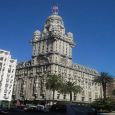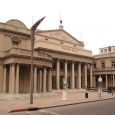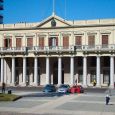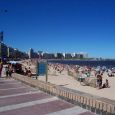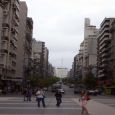Montevideo
Advertisement
By Air
The Aeropuerto Internacional de Carrasco, which serves Montevideo, is located 12 miles (19 km) from the city centre. Pluna, the Uruguayan national carrier, operates domestic and international flights. United, American and Aerolineas Argentinas also operate International flights to Montevideo from their respective countries.The airport serves over 1,500,000 passenger annually.Angel S. Adami Airport is a private airport operated by minor charter companies.
By Train
The State Railways Administration of Uruguay (AFE) operates three commuter rail lines,namely the Empalme Olmos,San Jose and Florida.These lines operate to major suburban areas of Canelones, San Jose and Florida.Within the Montevideo city limits,local trains stop at Lorenzo Carnelli,Yatai (Step Mill), Sayago, Columbus (line to San Jose and Florida),Penarol and Manga (line Empalme Olmos) stations.The historic 19th century General Artigas Central Station located in the neighbourhood of Aguada, six blocks from the central business district, was abandoned 1 March 2003 and remains closed.A new station, 500 metres (1,600 ft) north of the old one and part of the Tower of Communications modern complex, has taken over the rail traffic.
By Bus
The Direccion Nacional de Transporte (DNT),part of the national Ministry of Transport and Public Works, is responsible for the organization and development of Montevideo's transport infrastructure. A very good bus service network covers the entire city.An international bus station, the Tres Cruces Bus Terminal, is located on the lower level of the Tres Cruces Shopping Center, on the side of Artigas Boulevard.This terminal,along with the Baltazar Brum Bus Terminal (or Rio Branco Terminal) by the Port of Montevideo, handles the long distance and intercity bus routes connecting to destinations within Uruguay.
By Ferries
The port on Montevideo Bay is one of the reasons the city was founded.It gives natural protection to ships, although two jetties now further protect the harbour entrance from waves.This natural port is competitive with the other great port of Rio de la Plata, Buenos Aires.The main engineering work on the port occurred between the years 1870 and 1930.These six decades saw the construction of the port's first wooden pier, several warehouses in La Aguada, the north and south Rambla, a river port, a new pier, the dredged river basin and the La Teja refinery. A major storm in 1923 necessitated repairs to many of the city's engineering works.Since the second half of the 20th century, physical changes have ceased, and since that time the area has degraded due to national economic stagnation.
Advertisement
Palacio Salvo
Is a building in Montevideo, Uruguay, located at the intersection of 18 de Julio Avenue and Plaza Independencia.It was designed by the architect Mario Palanti,an Italian immigrant living in Buenos Aires,who used a similar design for his Palacio Barolo in Buenos Aires, Argentina.Finished in 1925, Palacio Salvo stands 100 metres high with the antenna included.It was built on the site where the Confiteria La Giralda was once located,a place renowned for being where Gerardo Matos Rodríguez wrote his tango La Cumparsita, in 1917.The building was originally intended to function as a hotel, possibly mixed with some private residential units.This did not work out, and it never functioned as a hotel. There is now a mixture of offices and private residences in the building.
Punta Carretas Lighthouse
Also known as Punta Brava Lighthouse,is a lighthouse in Punta Carretas,Montevideo,Uruguay.It was erected in 1876.The lighthouse has a height of 21 meters high and its light reaches 15 miles away, with a flash every ten seconds.In 1962, the lighthouse became electric.The lighthouse is important for guiding boats into the Banco Inglés Buceo Port or the entrance of the Santa Lucia River,west of Montevideo city.
Fortaleza del Cerro
Also known as Fortaleza General Artigas, is a fortress situated in Montevideo, Uruguay overlooking the Bay of Montevideo.It belongs to the barrio of Casabo, at the west of Villa del Cerro.It holds a dominant position on the highest hill of the department of Montevideo (popularly known as Cerro de Montevideo with its altitude of 134 meters above sea level the sea, on the opposite side of the bay.Its function was to defend the population of Montevideo and its port, on the rio de la Plata.Governor Francisco Xavier de Elio ordered construction in 1809 and it was completed in 1839;this was the last Spanish fort built in Uruguay.It has housed the Military Museum since 1916.
Parque Rodo
Is both a barrio (neighbourhood or district) of Montevideo,Uruguay and a park which lies mostly outside the limits of the barrio itself and belongs to Punta Carretas.The name "Rodo" has been given in memory of Jose Enrique Rodo,an important Uruguayan writer whose monument is in the southern side of the main park.On the north side of the main park is an artificial lake with a little castle housing a municipal library for children.An area to its west is used as an open air exhibition of photography.
Solis Theatre
Is the name of Uruguay's oldest theatre.It was built in 1856 and is currently owned by the government of Montevideo.It is located in Plaza Independencia (Ciudad Vieja).Tomas Giribaldi's La Parisina,considered the first Uruguayan national opera,was premiered at the Solis on September 14, 1878.In 1998,the government of Montevideo started a major reconstruction of the theatre,which included two U$S110.000 columns designd by Phillipe Starck.The reconstruction was completed in 2004 with the re-opening taking place in August of that year.Acoustic studies of the rehabilitation project was entrusted to the French studio Avel Acoustique (Jerome Falala).
18 de Julio Avenue
Is the most important avenue in Montevideo, Uruguay.It is named after the date the first Constitution of Uruguay was written July 18, 1830.It starts from Plaza Independencia at the limits of the Ciudad Vieja (the Old City), crosses the barrios Centro and Cordon and ends at the Obelisk of Montevideo in Tres Cruces, where it meets Artigas Boulevard.Although not the widest or longest avenue of the city, it is considered as the most important of Montevideo, both as a commercial center and because of the many tourist attractions along its length.
Information not available
Information not available
Advertisement

